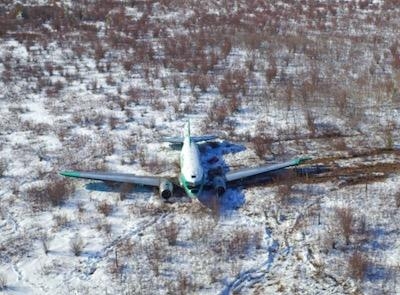Finds Landing Gear Was Extended Early During Emergency Return To The Airport
The Transportation Safety Board of Canada (TSB) has released a final report from an accident which occurred on May 3, 2019 involving a Buffalo Airways DC-3 which suffered an engine issue shortly after takeoff from Hay River/Merlyn Carter Airport.

After departure, while the aircraft was climbing through 1200 feet above sea level (ASL) on the way to a cruising altitude of 5000 feet ASL, the flight crew completed the after-takeoff checklist and applied carburetor heat to 20 °C.
While the First Officer was applying the carburetor heat, oil pressure was observed decreasing on the left engine (Pratt & Whitney R-1830-92). Moments later, rising cylinder head temperature and oil temperature indications were also observed on the left engine. The captain directed the FO to contact the area control center to declare a PAN PAN emergency and request a return to CYHY, which the FO then did. The aircraft flight manual (AFM) does not contain any procedures for abnormal engine indications.
As the aircraft reached an altitude of 1969 feet ASL, the captain set the left engine to a reduced power setting and increased the power on the right engine to maximum except takeoff (METO) power. The flight crew began to set up for an instrument landing system approach to CYHY via TANPO.
At 0747, while the aircraft was in a right turn proceeding towards TANPO, smoke and oil were observed, and abnormal sounds were heard coming from the left engine. Using the engine failure checklist, the flight crew then shut down the left engine and feathered the propeller. At 0748, because the situation had escalated, a MAYDAY emergencyFootnote7 was declared. Moments later, the flight crew completed the descent checklist and initiated the approach checklist. However, due to the escalating emergency, the flight crew was not able to complete the approach checklist, which included the landing briefing.
At 0753, the aircraft levelled off at 1214 feet ASL. The FO observed zero hydraulic pressure on the landing gear DOWN gauge. Thinking this zero pressure was an issue, he mentioned it to the captain, who then directed the FO to “prep the gear.” The FO extended the landing gear, which the captain did not expect because the aircraft had not started its final approach and the airport had not been visually acquired.
At 0755, as the aircraft continued towards TANPO, the altitude was between 1200 and 1300 feet ASL, and the airspeed was maintained at approximately 100 knots indicated airspeed (KIAS). When the aircraft was abeam TANPO, the captain began a right turn to intercept the localizer for the final approach. The aircraft’s airspeed decreased from 100 KIAS to 80 KIAS, while its altitude decreased to 1100 feet ASL. With the reduced airspeed, the aircraft’s flight control response became sluggish and the captain directed the landing gear to be raised.
After the landing gear was raised, at 0759, the flight crew heard abnormal sounds and felt vibrations from the right engine. The aircraft’s airspeed was 80 KIAS, and its altitude began to decrease to below 800 feet ASL.
In an attempt to maintain altitude, the right engine was increased to maximum takeoff power, but this had no effect. The flight crew then prepared for an emergency gear-up landing, and the aircraft’s flaps were lowered on short final to reduce speed for touchdown.
At 0801, the aircraft landed in muskeg on K’atl’Odeeche First Nation land, approximately 3.5 nautical miles southeast of CYHY. After the aircraft came to a stop, the FO exited the aircraft through the right-hand crew window, while the captain remained in the cockpit to secure the right engine and aircraft systems before evacuating via the forward door. The FO contacted the flight information centre to notify them of the crew’s status and aircraft location. The emergency locator transmitter had not activated during the forced landing, so the FO activated it manually to assist search and rescue in locating the aircraft. The flight crew was uninjured. The aircraft received substantial damage. There was no post-impact fire. First responders arrived at the accident site at 1114.
According to the TSB, in this occurrence, the aircraft’s airspeed and altitude could not be maintained, primarily because of the increased drag when the landing gear was extended early in the approach. This highlights the need to follow SOPs and use standard phraseology, as well as the importance of checklist discipline, during an emergency.
(Image provided with the TSB report)
 ANN's Daily Aero-Term (04.24.24): Runway Lead-in Light System
ANN's Daily Aero-Term (04.24.24): Runway Lead-in Light System ANN's Daily Aero-Linx (04.24.24)
ANN's Daily Aero-Linx (04.24.24) Aero-FAQ: Dave Juwel's Aviation Marketing Stories -- ITBOA BNITBOB
Aero-FAQ: Dave Juwel's Aviation Marketing Stories -- ITBOA BNITBOB Classic Aero-TV: Best Seat in The House -- 'Inside' The AeroShell Aerobatic Team
Classic Aero-TV: Best Seat in The House -- 'Inside' The AeroShell Aerobatic Team Airborne Affordable Flyers 04.18.24: CarbonCub UL, Fisher, Affordable Flyer Expo
Airborne Affordable Flyers 04.18.24: CarbonCub UL, Fisher, Affordable Flyer Expo



